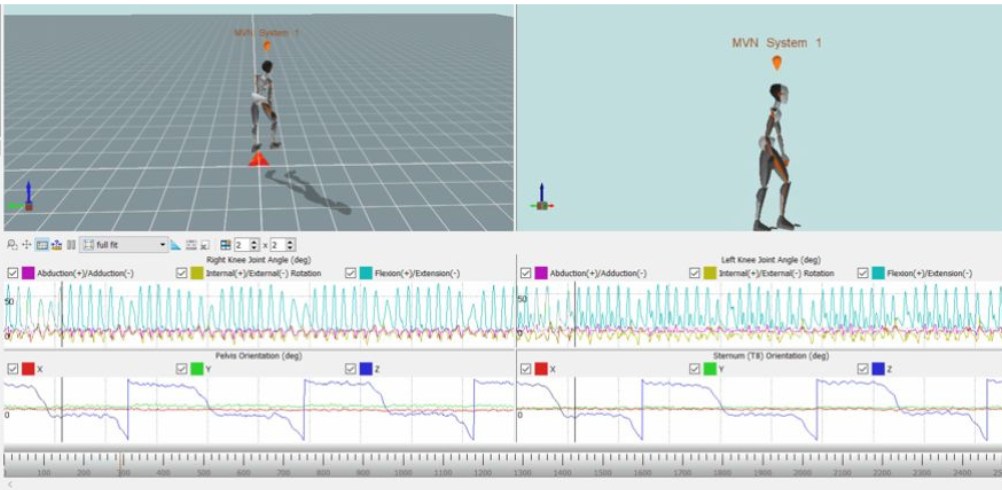Advancements in motion capture technology are transforming patient rehabilitation, as demonstrated by recent research combining Xsens technology with an innovative real-time biofeedback device. This approach promises to significantly enhance balance control and rehabilitation outcomes for patients with diverse balance and movement challenges.
Key takeaways:
- A new device to improve balance: Dr. Hande Argunsah and PhD candidate Begum Yalcin developed a wearable device with real-time haptic biofeedback that helps patients maintain better balance during physical activities.
- Accurate motion analysis with Xsens: The researchers chose Xsens Awinda to conduct device validation because the system provides precise data for evaluating the effectiveness of balance-improving devices.
- Increased engagement: Using a 3D avatar in therapy sessions improves patient motivation and extends stamina during rehabilitation exercises.
- Broad future research: The technology is being adapted for various conditions, such as Parkinson’s disease, scoliosis, and osteoarthritis research, to refine treatment methods.
Published in the Journal of Enabling Technologies.
Today, patient rehabilitation is becoming more data-driven with the introduction of new technology, such as motion capture, providing precise and detailed patient movement analysis and in-depth insights. The researchers from Acibadem Mehmet Ali Aydinlar University in Istanbul, Turkey, Dr. Hande Argunsah and PhD candidate Begum Yalcin used Xsens motion capture technology to address complex challenges in balance and motion analysis. Their innovative work not only demonstrates the potential of advanced motion capture systems, but also opens up new avenues for improving rehabilitation practices and patient outcomes.
Addressing the challenge
Medulloblastoma, a type of brain cancer affecting the cerebellum, often results in significant motor impairments, making balance and coordination a daily struggle for patients. Traditional rehabilitation methods may not fully address these issues, underscoring the need for more responsive and adaptive solutions. Recognizing this, Dr. Argunsah and Yalcin embarked on developing a groundbreaking wearable device aimed at monitoring and improving balance in real-time. Their research involved a 16-year-old patient with medulloblastoma. The device, placed on the sternum, tracks balance losses and movement patterns while providing immediate haptic feedback through vibrations, aimed at helping patients correct their movements and improve stability.
.png?width=2300&height=1799&name=Medulloblastoma%20research%201%20(edited).png)
Control participant and patient participant perform the 10-meter walking test
To validate their device, Dr. Argunsah and Yalcin turned to Xsens motion capture technology, provided by the official distributor of Xsens in Turkey, Sense4Motion. Xsens was instrumental in capturing detailed motion data and assessing the effectiveness of their device.
The role of Xsens
In the research, Xsens Awinda was used to enable a comprehensive analysis of knee joint kinematics and center of mass orientation. By comparing movement patterns with and without the biofeedback device, Xsens provided a thorough evaluation of the device’s impact on balance and stability.
The choice of Xsens for the research was based on several considerations. As Dr. Argunsah explains, "Xsens provides a lot of freedom, so we can take the device anywhere we want. As the data collection can be done anywhere while wearing daily clothing, patients can feel more comfortable. This also allows our students to be present and observe data collection."
Dr. Argunsah also emphasized the patient’s positive response to the real-time Xsens 3D avatar, noting that it brings engagement and motivation during the rehabilitation journey.
" [Patients] are happy, and the 3D avatar captures their attention. During static tests, single leg stance tests, and while sitting with arms extended, the duration that patients can remain in the position increased when they were shown the 3D avatar. As they focused on the avatar, their motivation grew, leading to a significant increase in their stamina throughout the physical therapy session, especially during the single-leg assessment".
Key research insights
The integration of Xsens technology with the novel wearable device brought promising results. The device effectively improved movement patterns, bringing them closer to those observed in control subjects. More importantly, it significantly reduced the frequency of balance losses when biofeedback was provided, highlighting its potential for enhancing patient stability.
.png?width=1002&height=490&name=Medulloblatoma%20research%202%20(edited).png)
Medulloblastoma patient performing the 10-meter walking test without biofeedback
Looking Ahead
Dr. Argunsah and her research group are planning to expand their studies to include patients with Parkinson’s disease, scoliosis, and osteoarthritis, alongside other neurological and orthopedic conditions. By leveraging Xsens, they aim to gather extensive data and refine therapeutic interventions, ultimately developing advanced algorithms and treatments to better manage motor impairments and improve rehabilitation processes. Specifically, they aim to improve joint function and mobility in individuals with osteoarthritis by creating an algorithm to identify the severity of the condition.
By combining innovative technologies with rigorous research, Dr. Argunsah and her research group are paving the way for more effective treatments and improved quality of life for patients with complex motor challenges.
Conclusion
The findings of this research showcase the profound impact that advanced motion capture technology such as Xsens can have on patient rehabilitation. Dr. Argunsah notes that, based on their experience with Xsens, which they have been using since 2019, this technology may be applied effectively in the domains of health and rehabilitation, as well as ergonomics, sports, and animation.

.png?width=2300&height=1799&name=Medulloblastoma%20research%201%20(edited).png)
.png?width=1002&height=490&name=Medulloblatoma%20research%202%20(edited).png)



